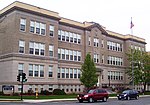Natural Bridge State Park (Massachusetts)
1985 establishments in MassachusettsLandforms of Berkshire County, MassachusettsMassachusetts natural resourcesNatural arches of MassachusettsNorth Adams, Massachusetts ... and 4 more
Parks in Berkshire County, MassachusettsProtected areas established in 1985State parks of MassachusettsUse mdy dates from August 2023

Natural Bridge State Park is a Massachusetts state park located in the city of North Adams in the northwestern part of the state. Named for its natural bridge of white marble, unique in North America, the park also offers woodland walks with views of a dam made of white marble, and a picturesque old marble quarry.
Excerpt from the Wikipedia article Natural Bridge State Park (Massachusetts) (License: CC BY-SA 3.0, Authors, Images).Natural Bridge State Park (Massachusetts)
McCauley Road,
Geographical coordinates (GPS) Address Phone number Website External links Nearby Places Show on map
Geographical coordinates (GPS)
| Latitude | Longitude |
|---|---|
| N 42.706666666667 ° | E -73.092777777778 ° |
Address
Natural Bridge State Park
McCauley Road
01247
Massachusetts, United States
Open on Google Maps








